
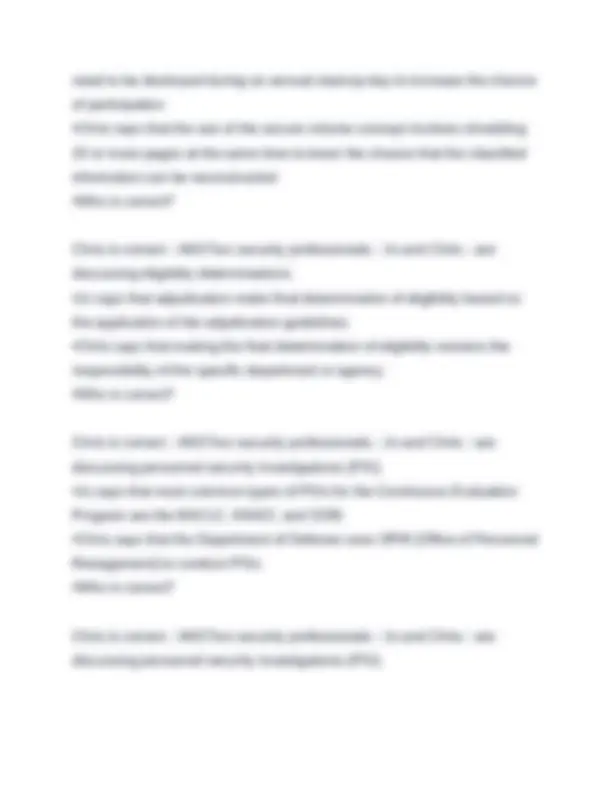

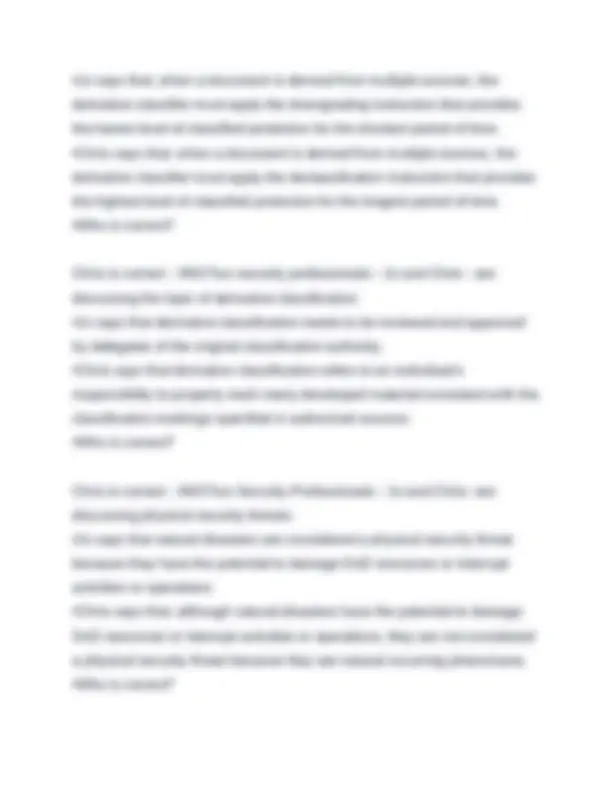
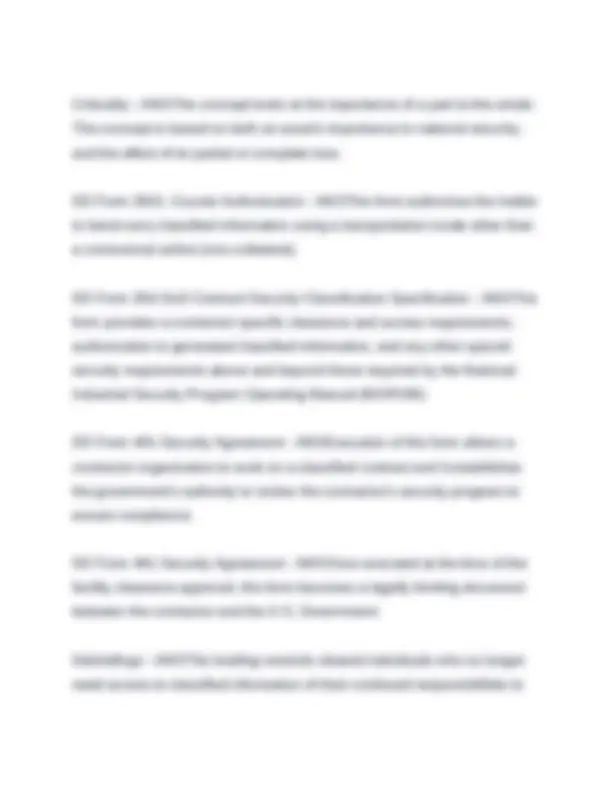
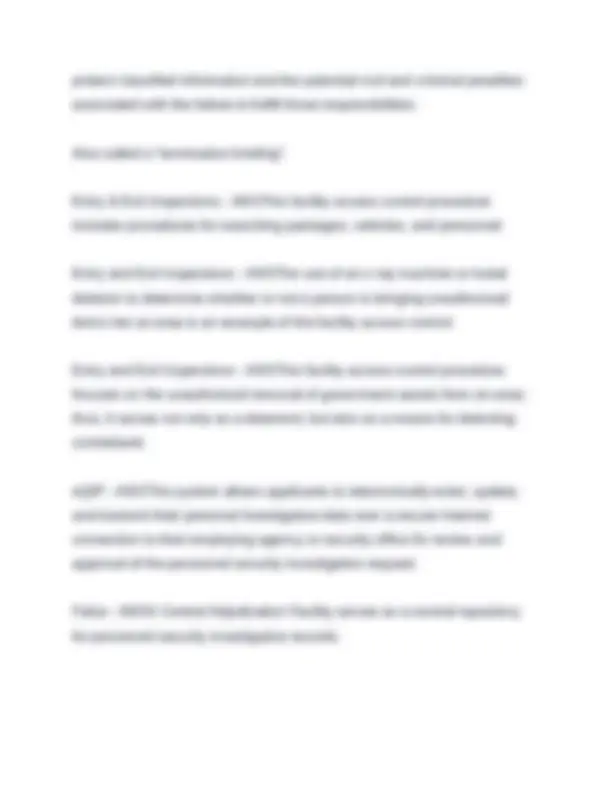
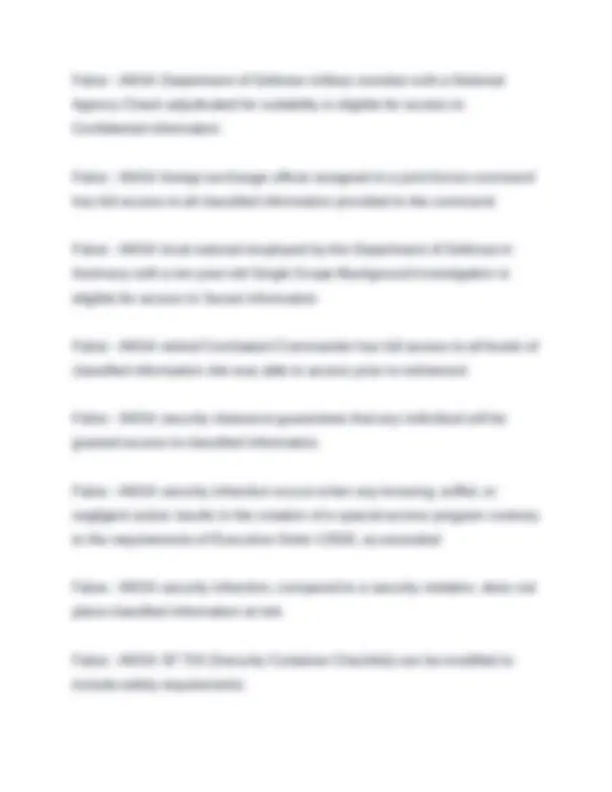
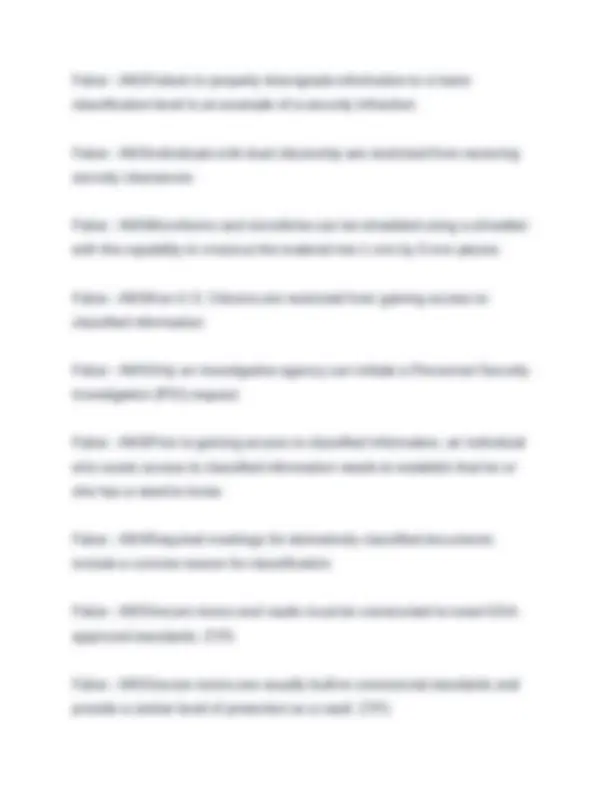
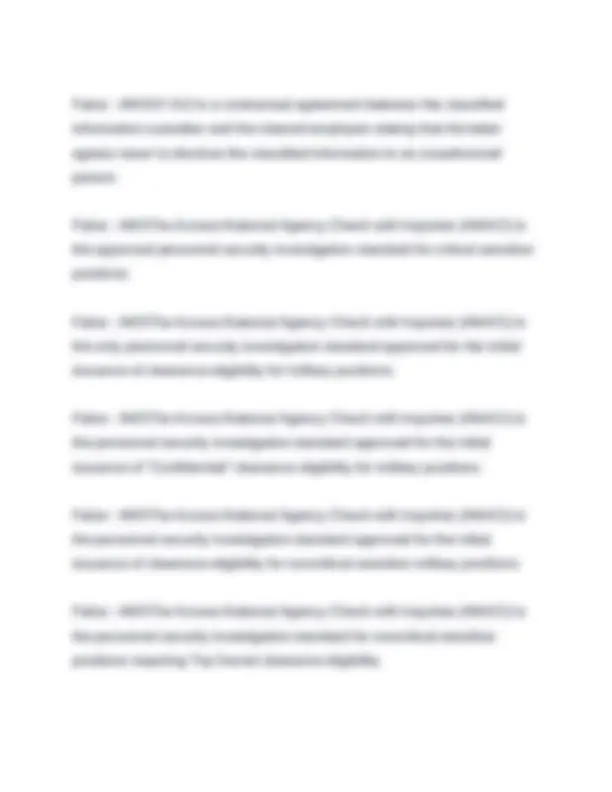
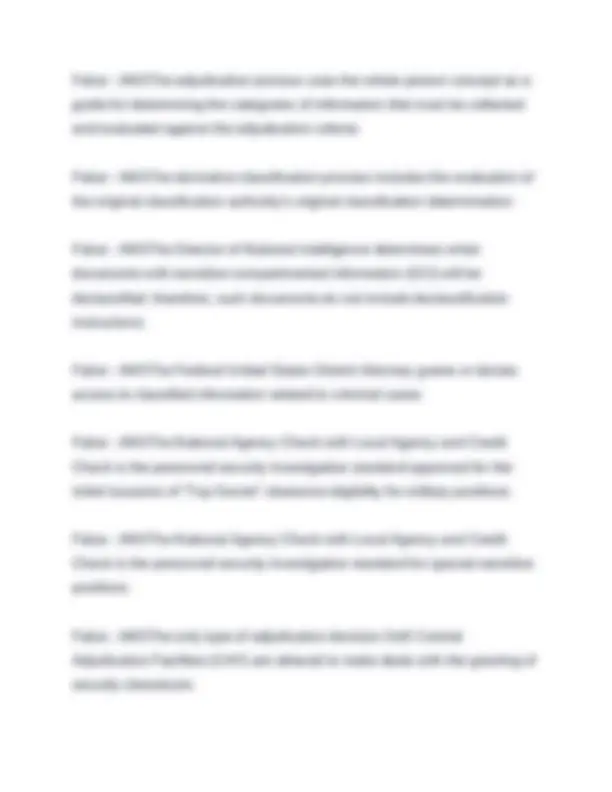
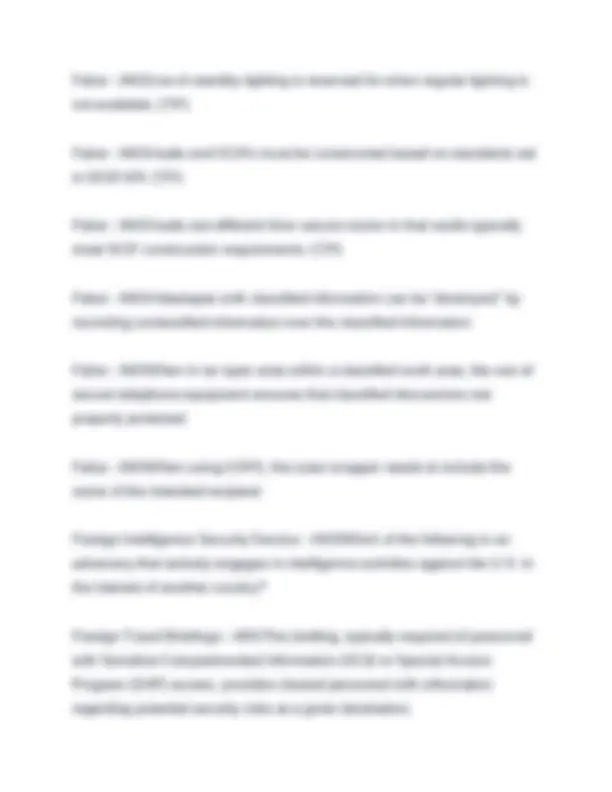
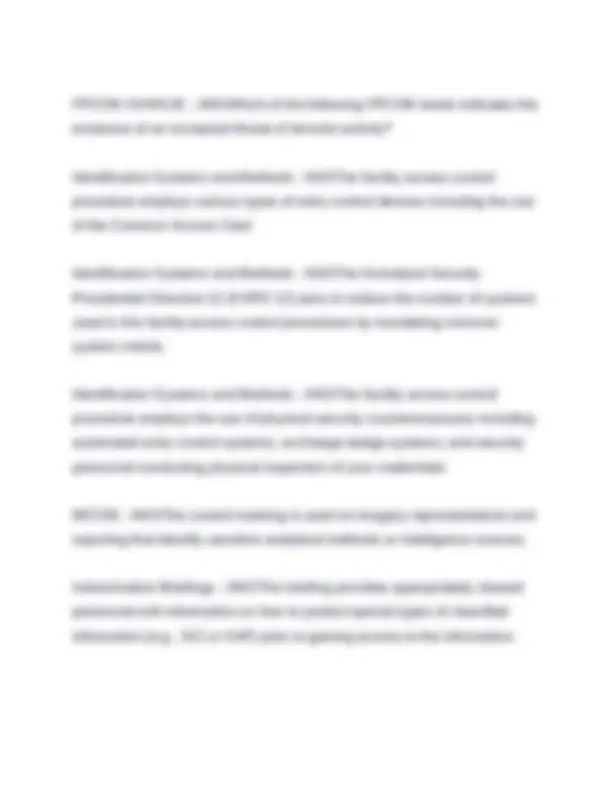
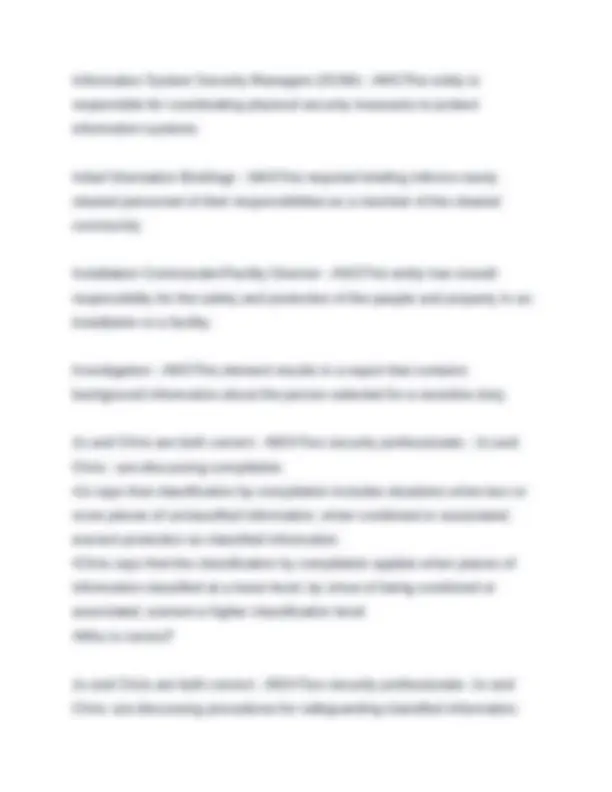
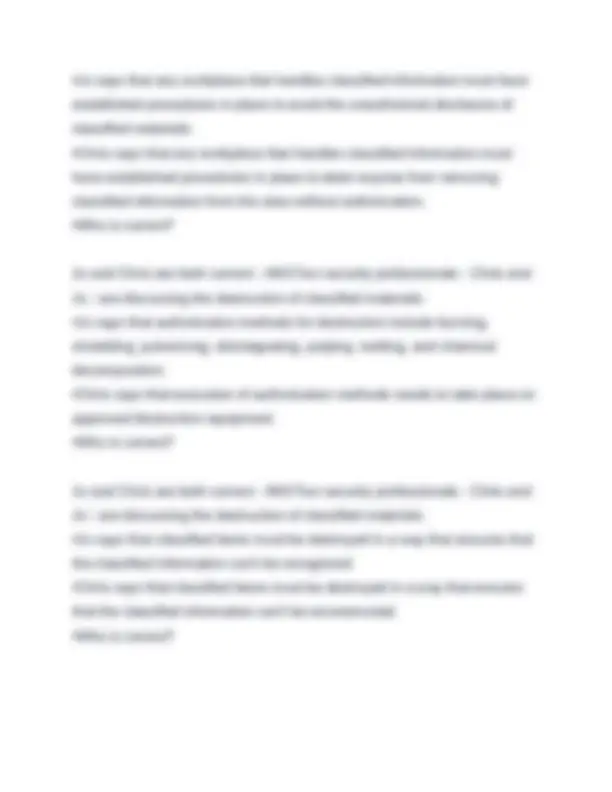
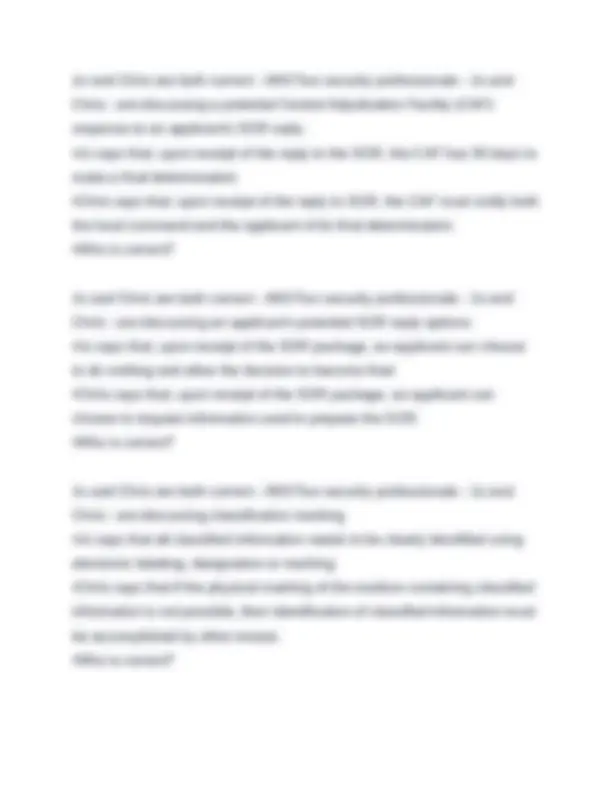
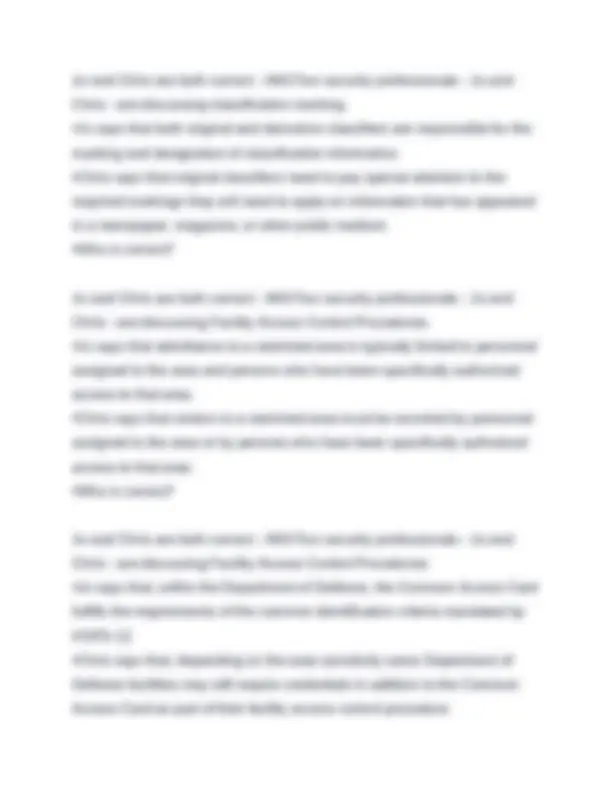
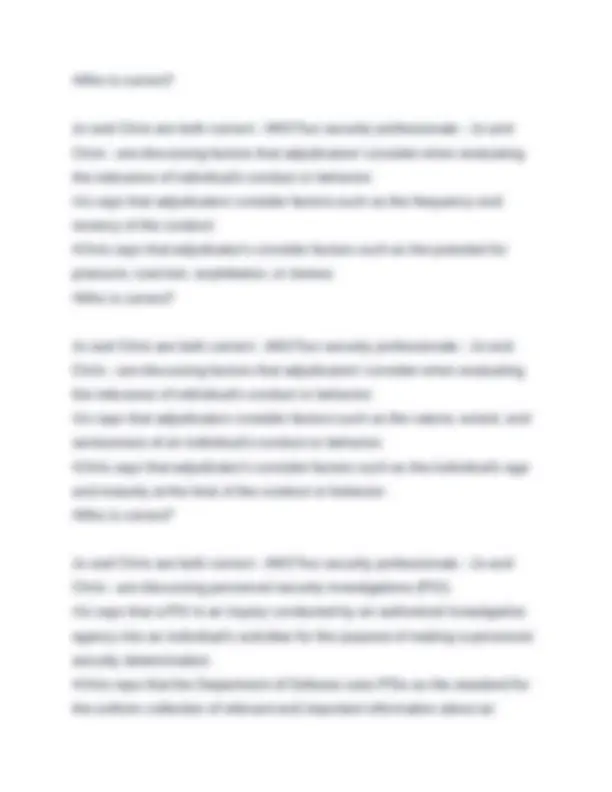
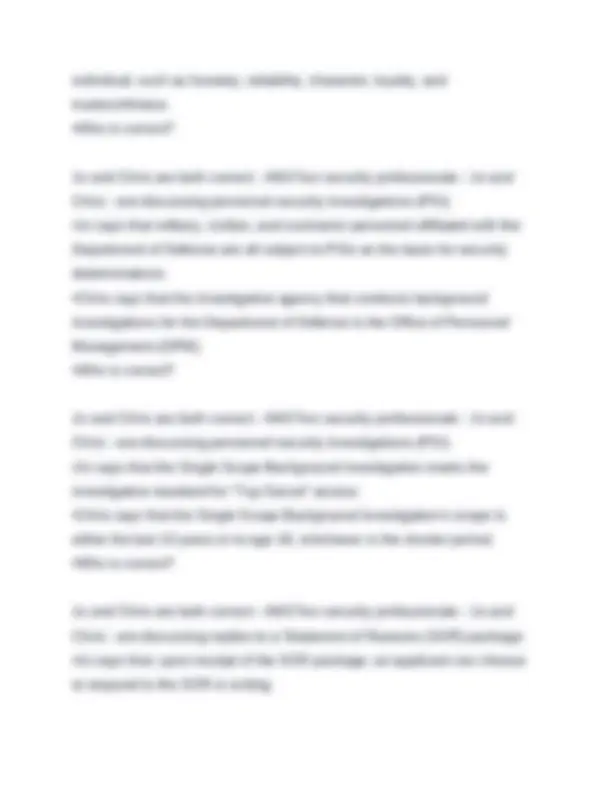
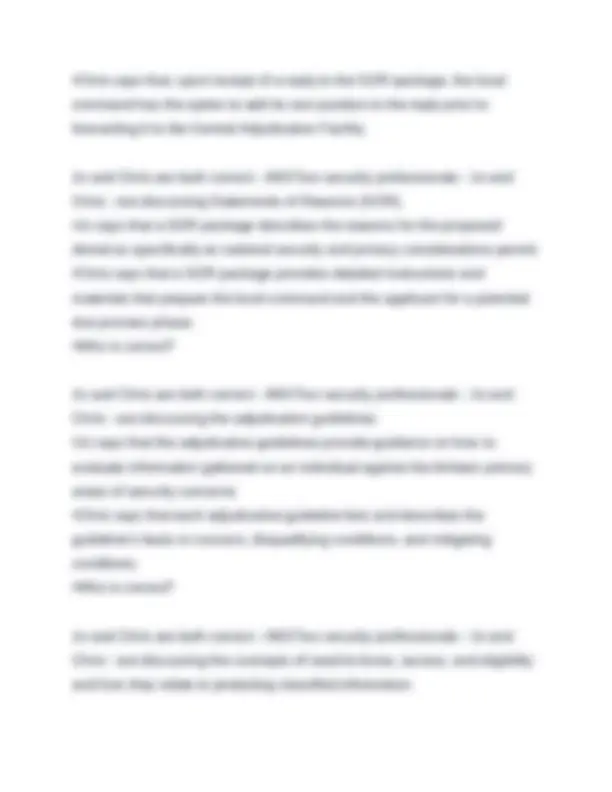
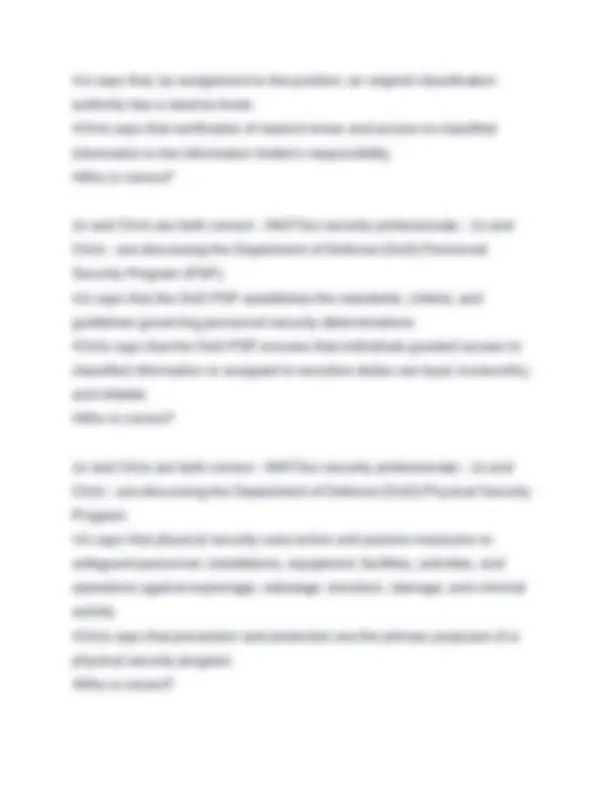

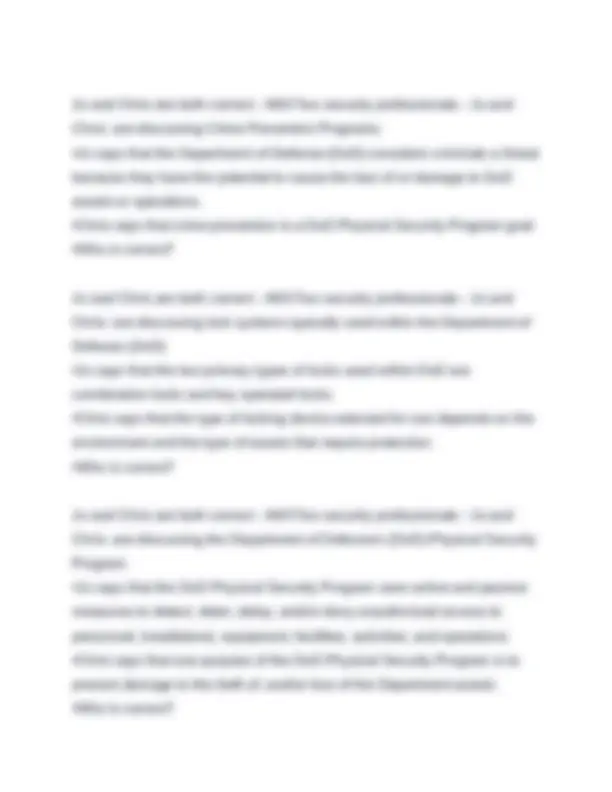
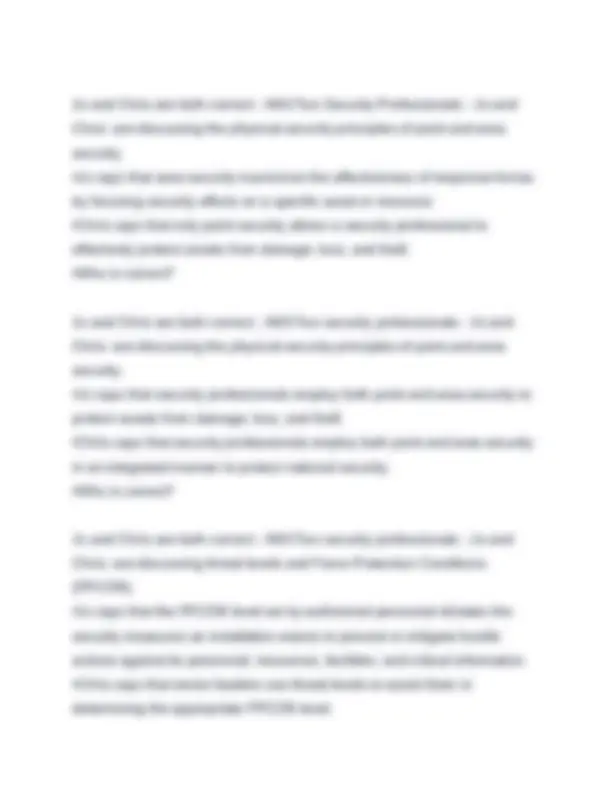
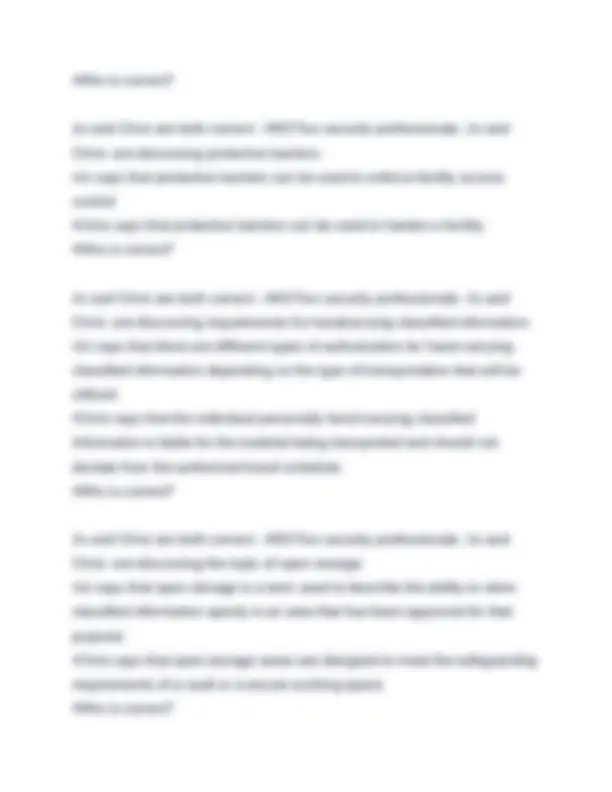
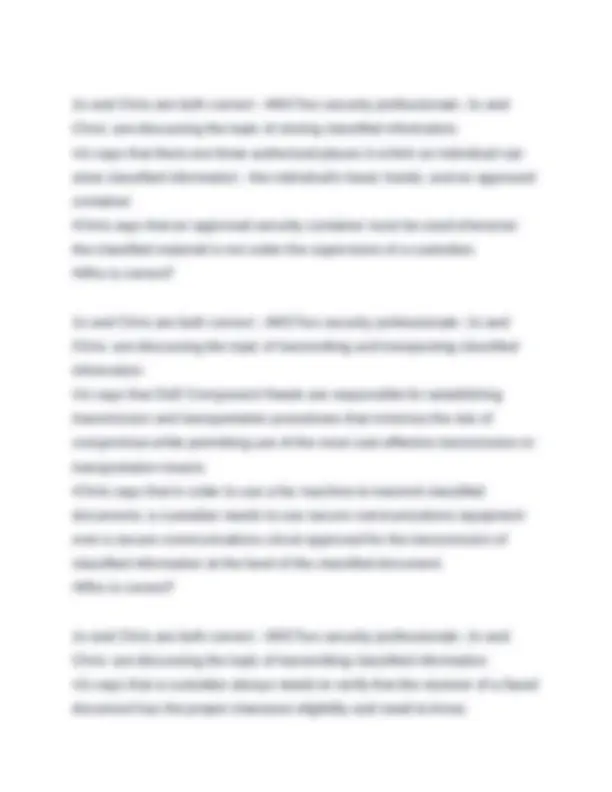
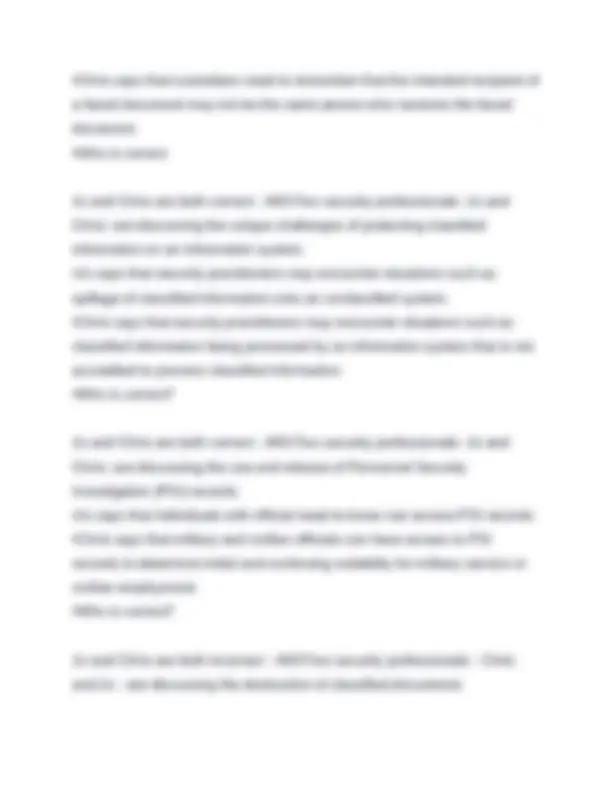
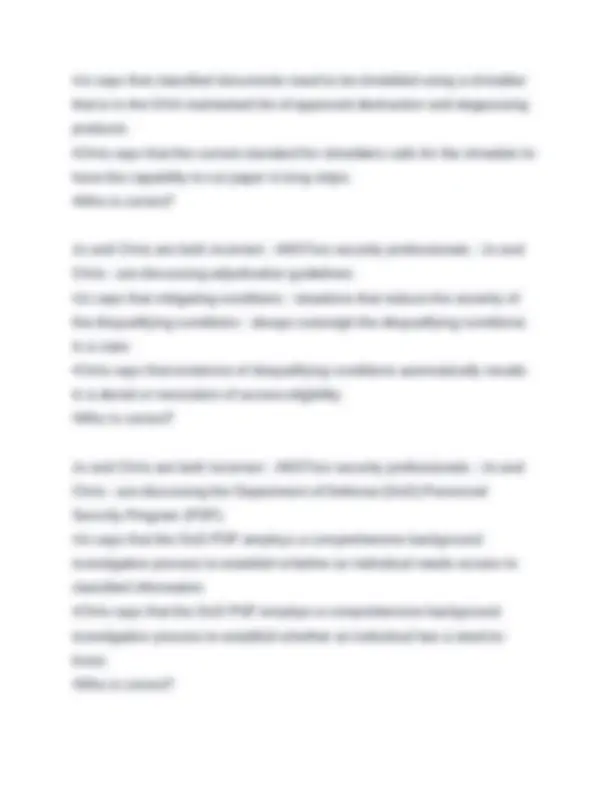
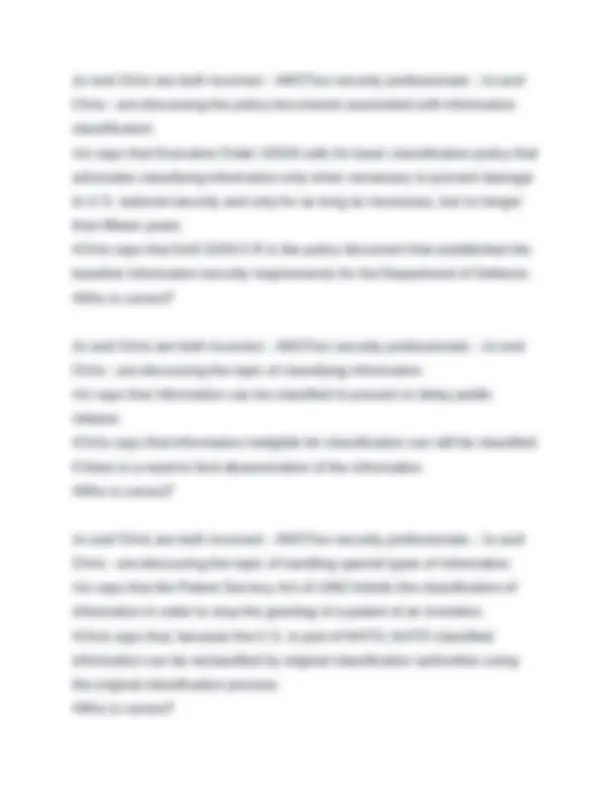
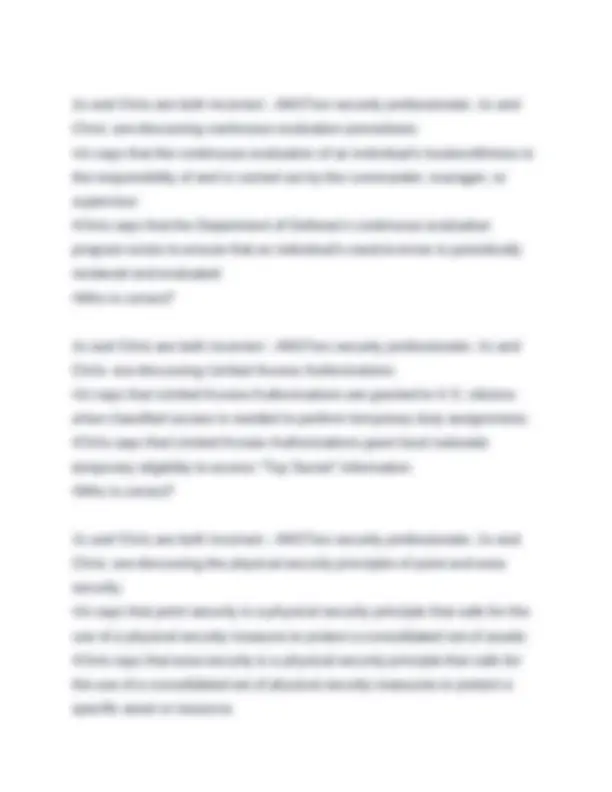
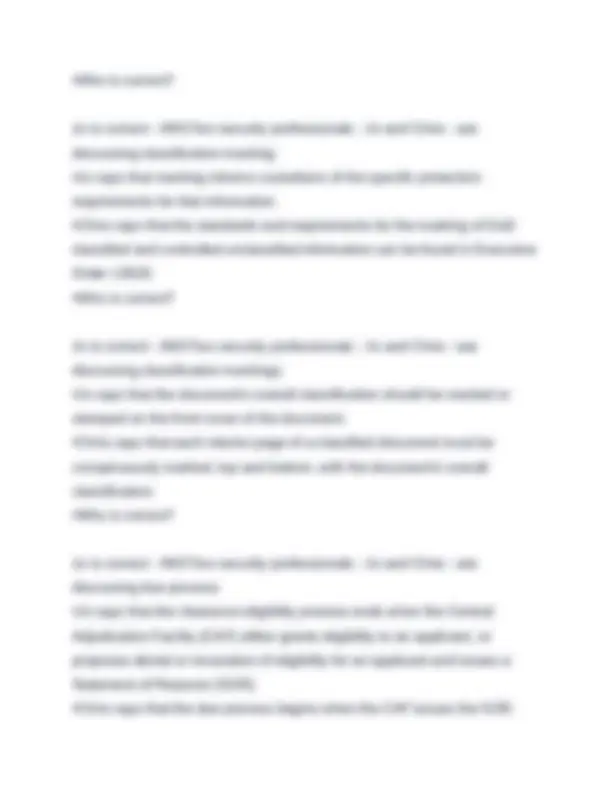
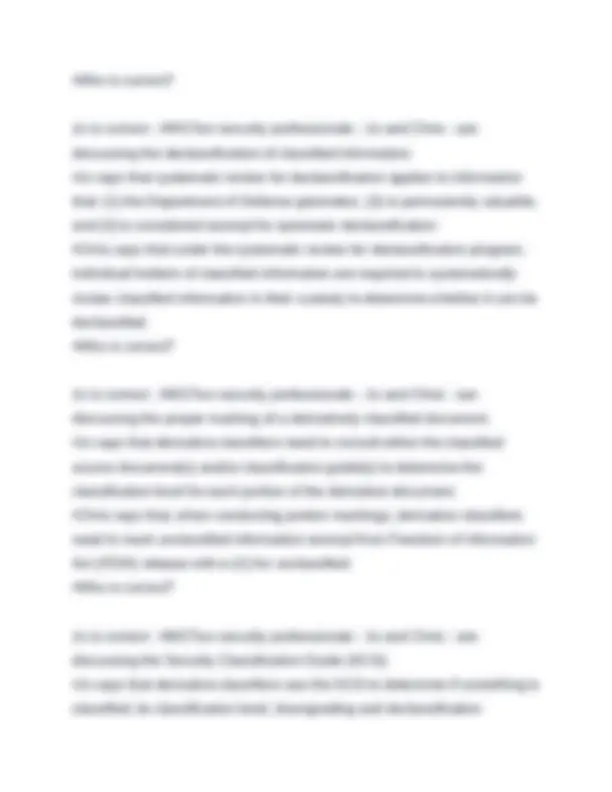
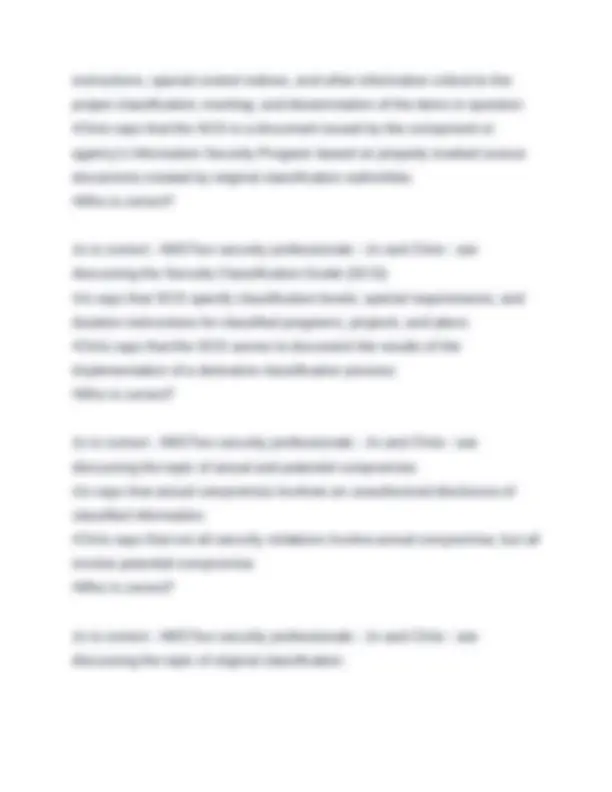
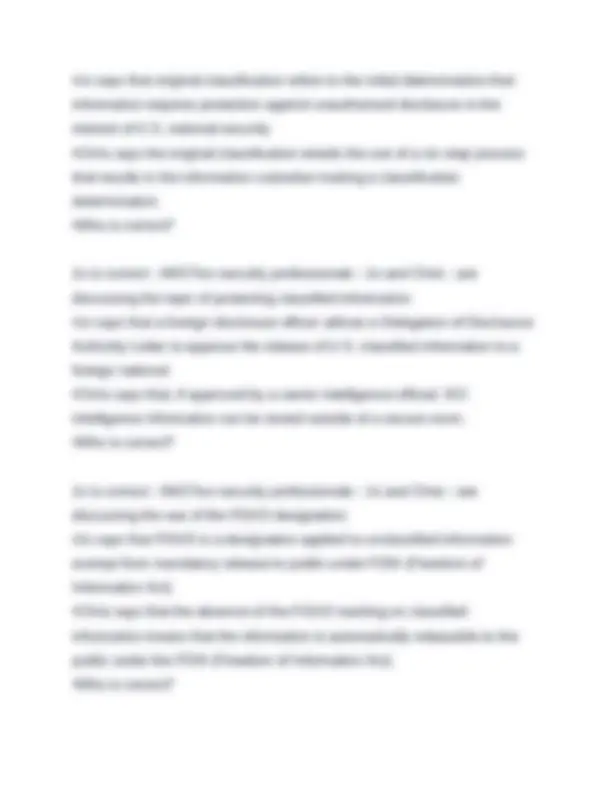
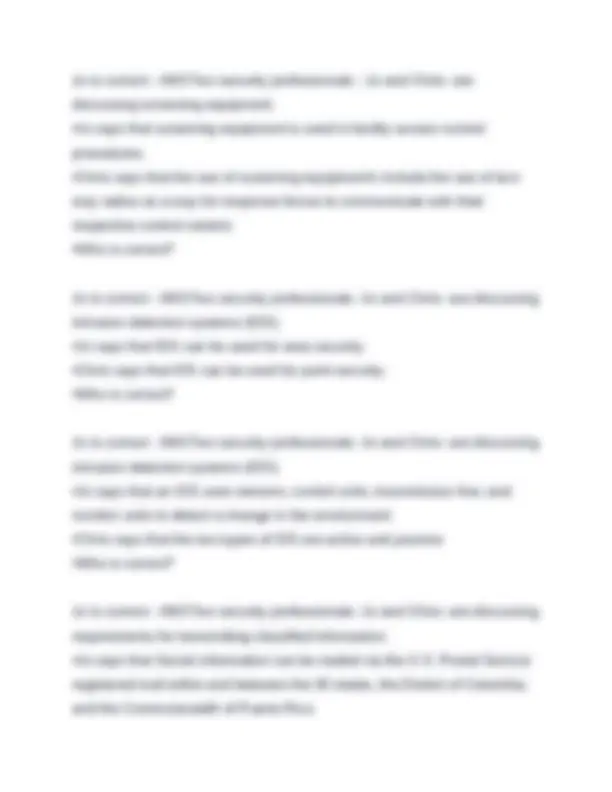
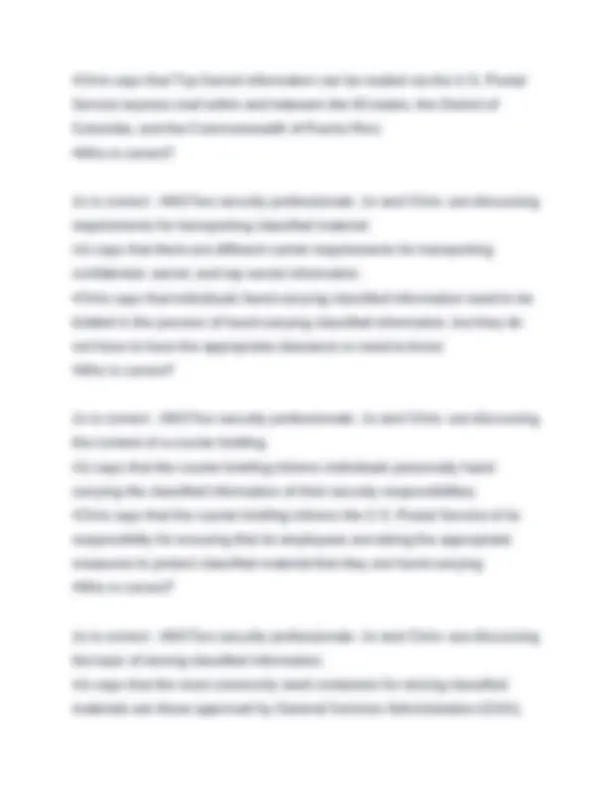
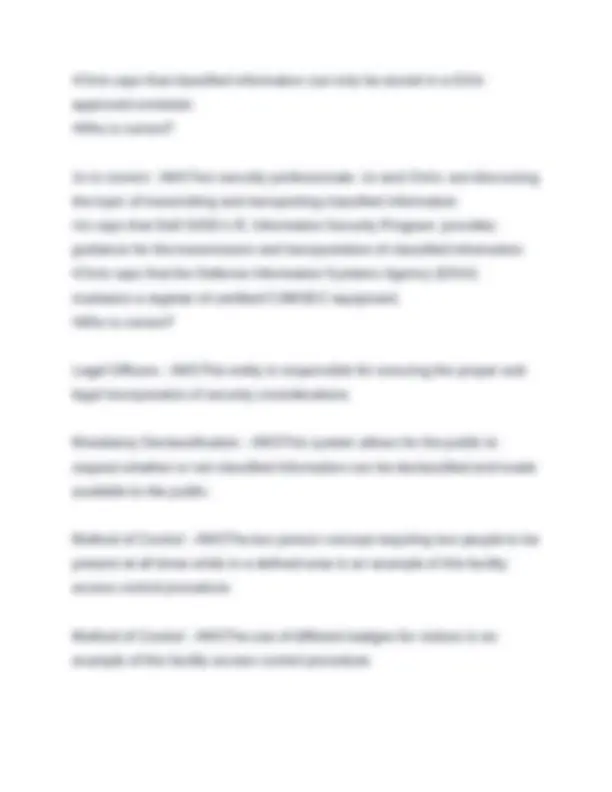
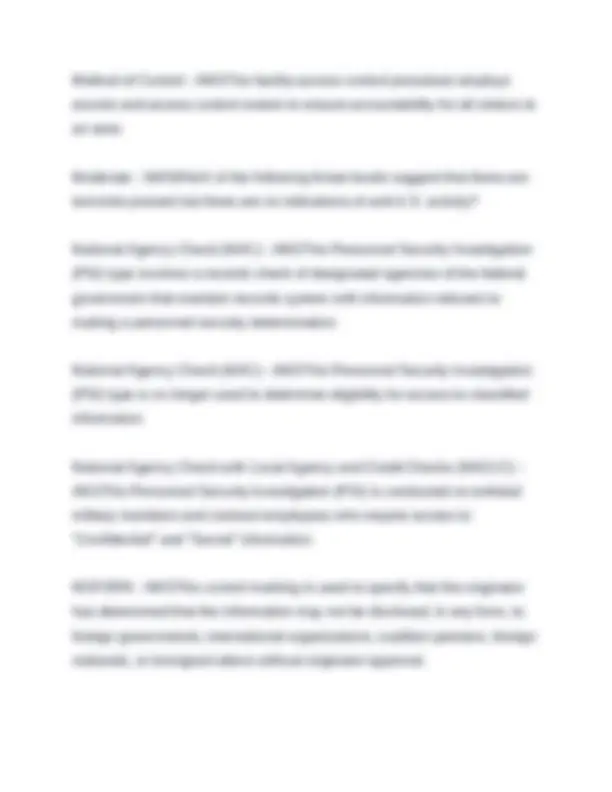
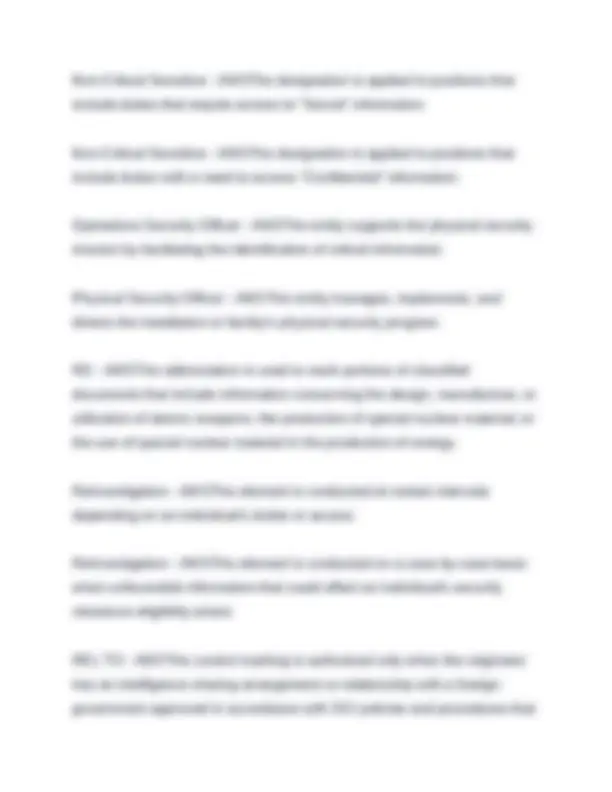
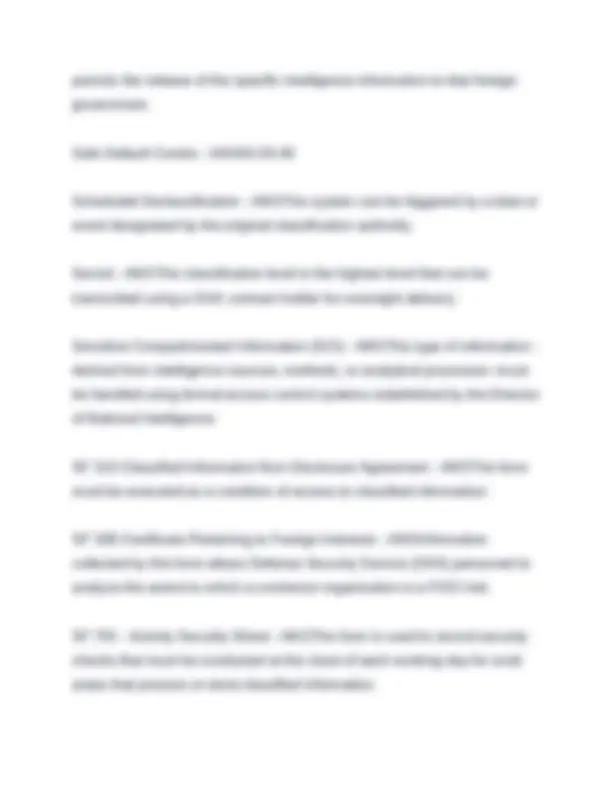
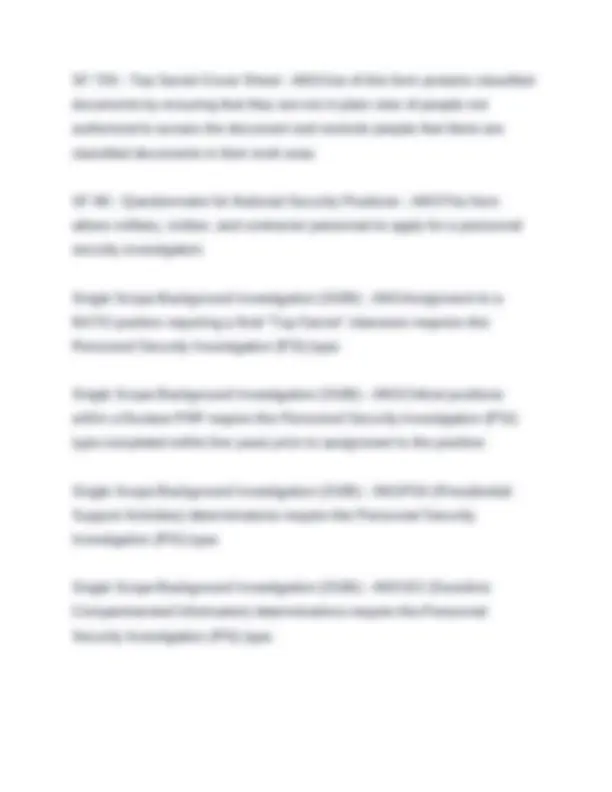

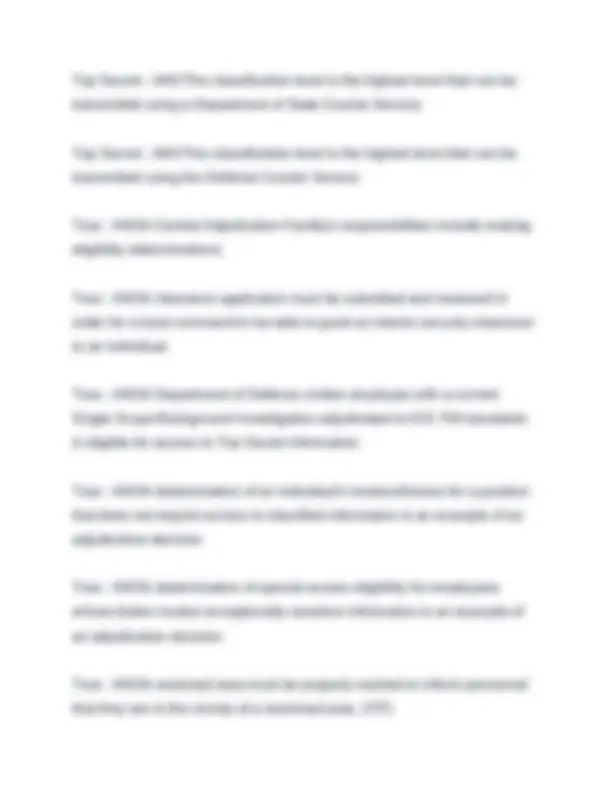
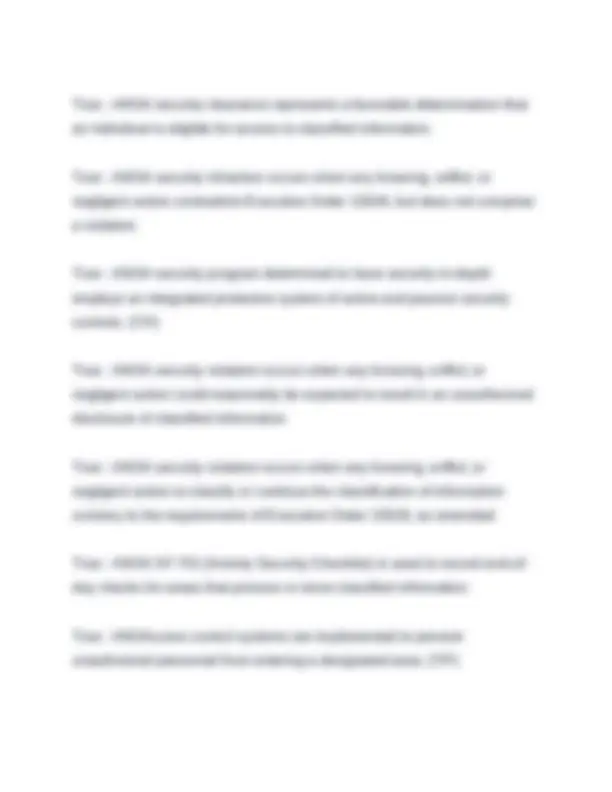
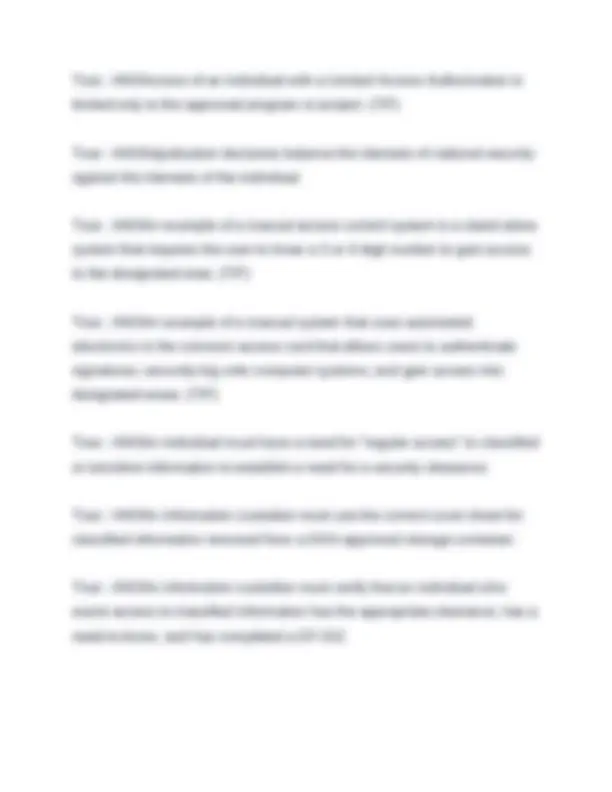
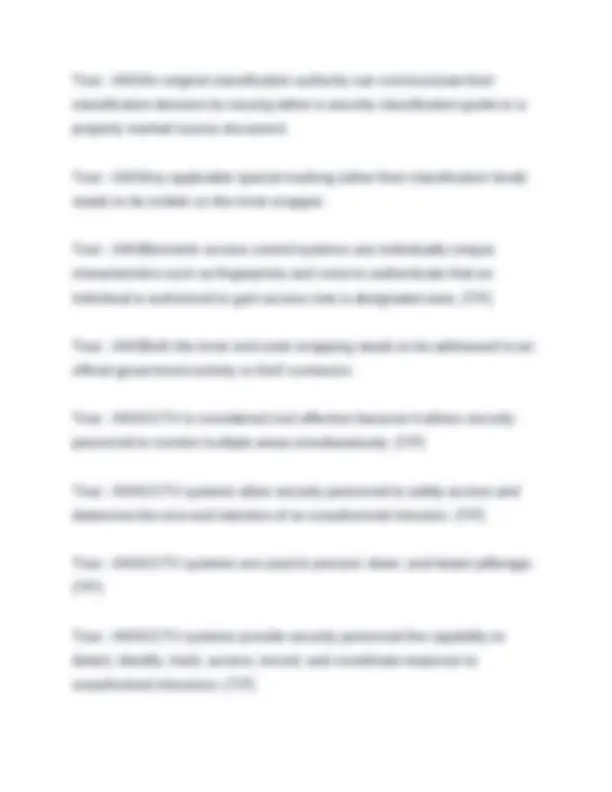
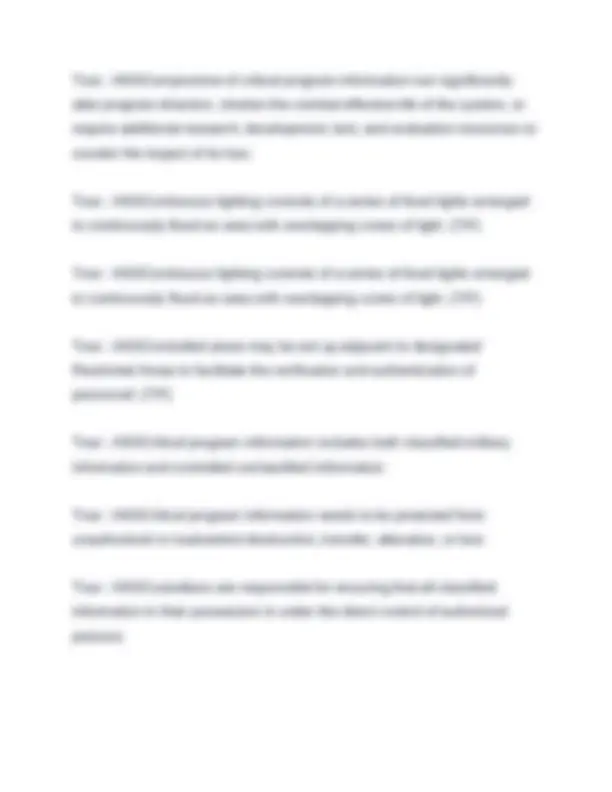
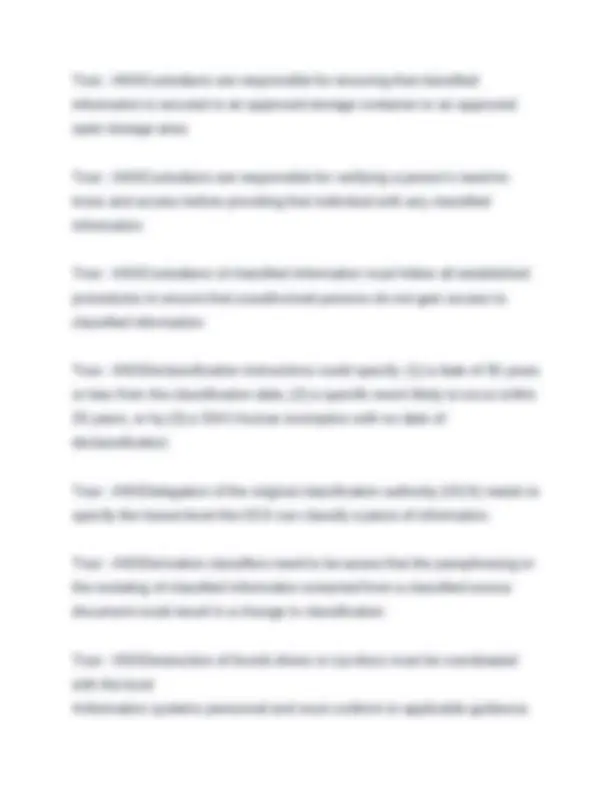
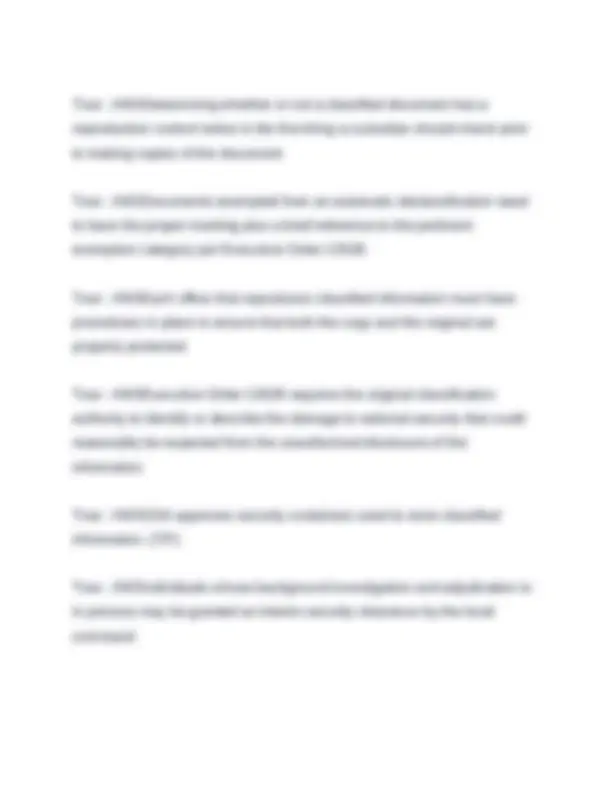
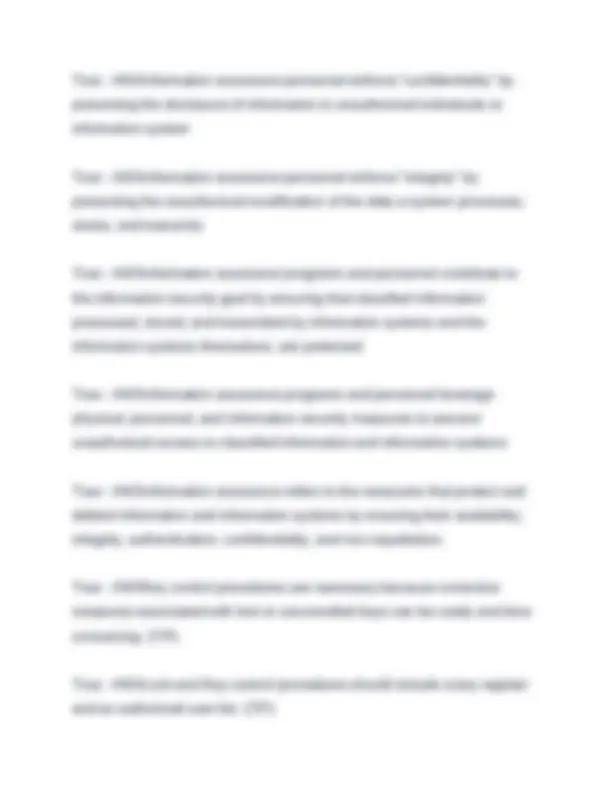
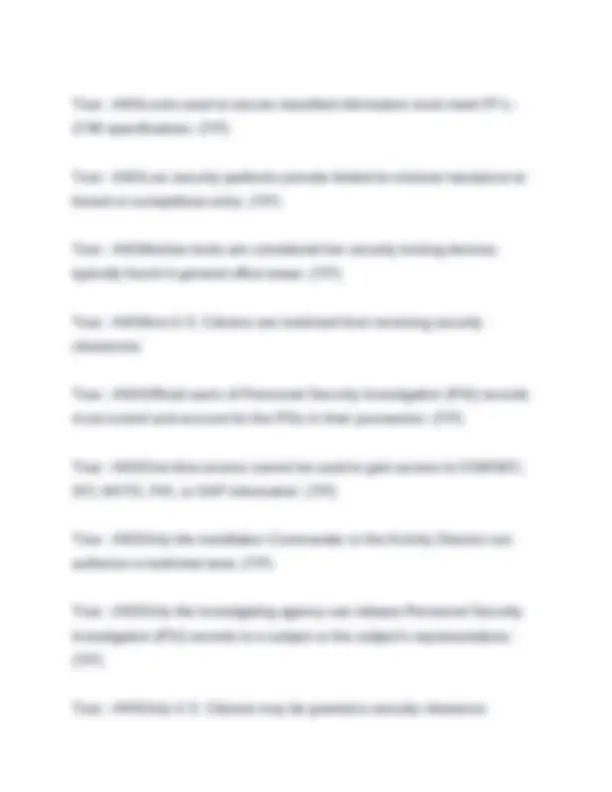
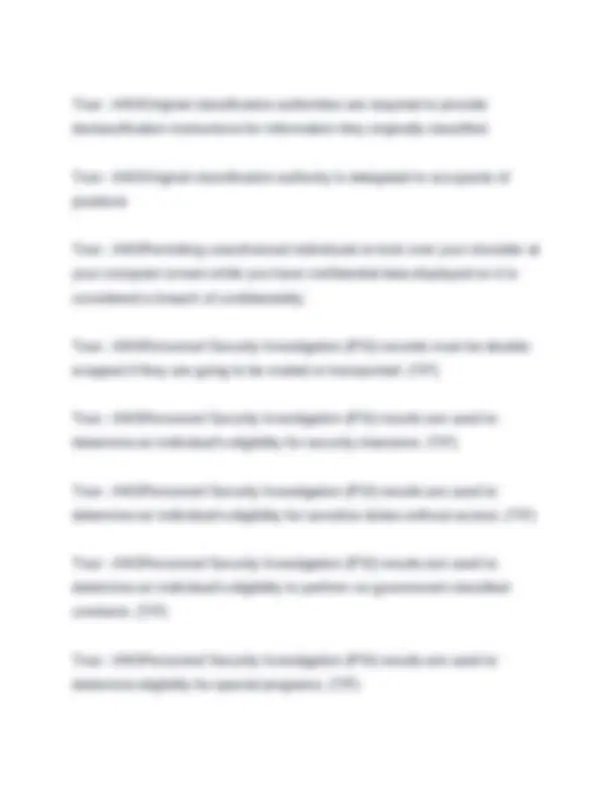
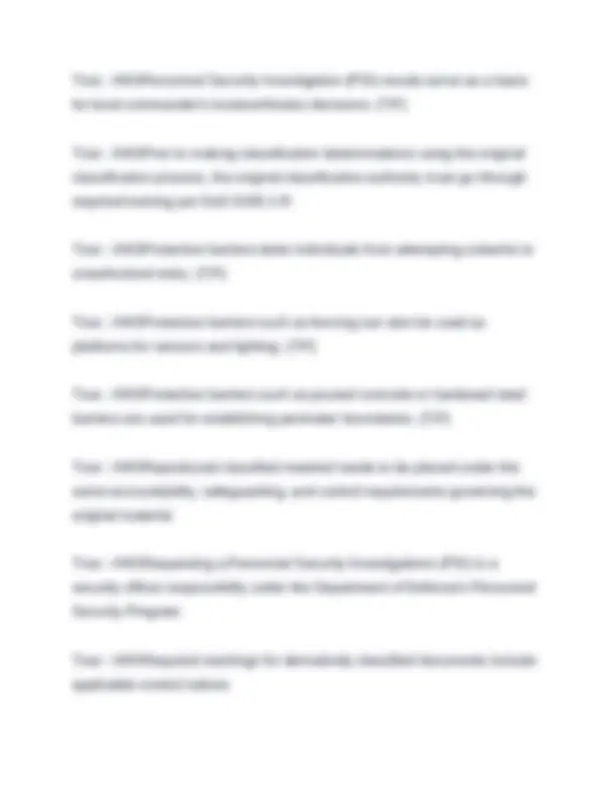
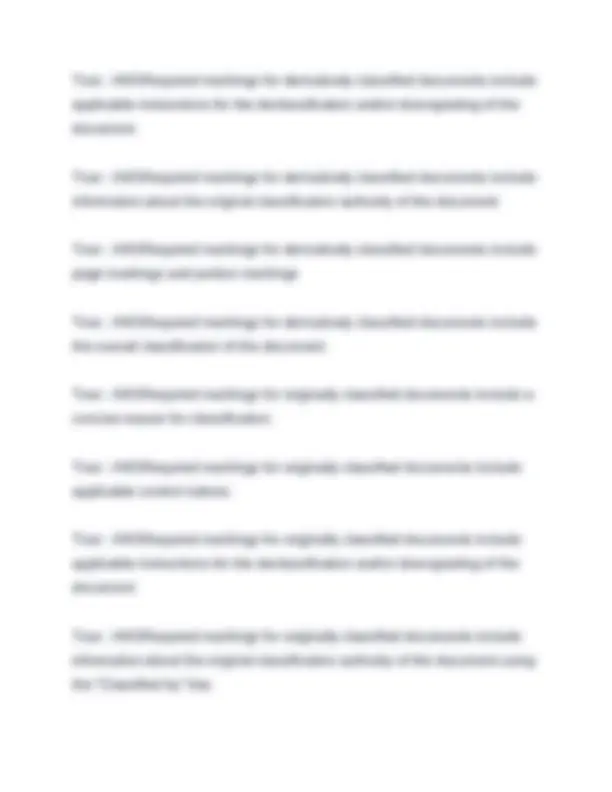
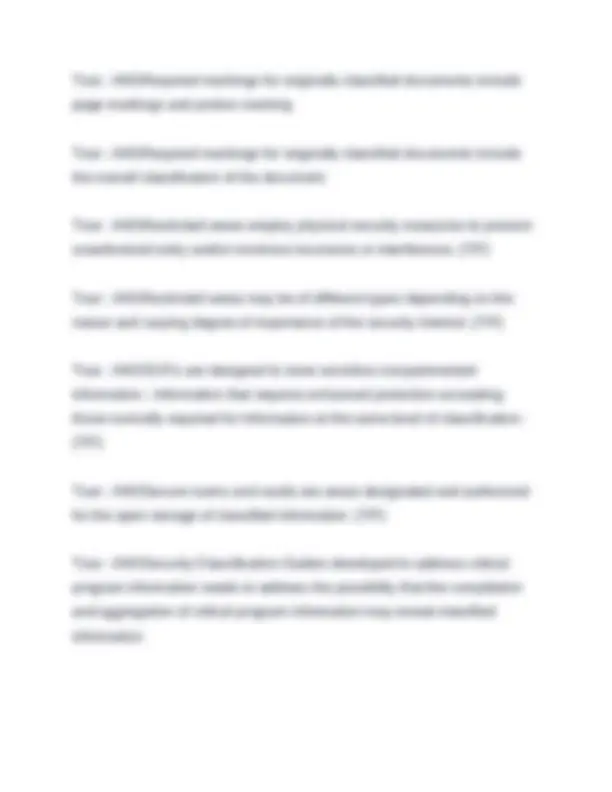
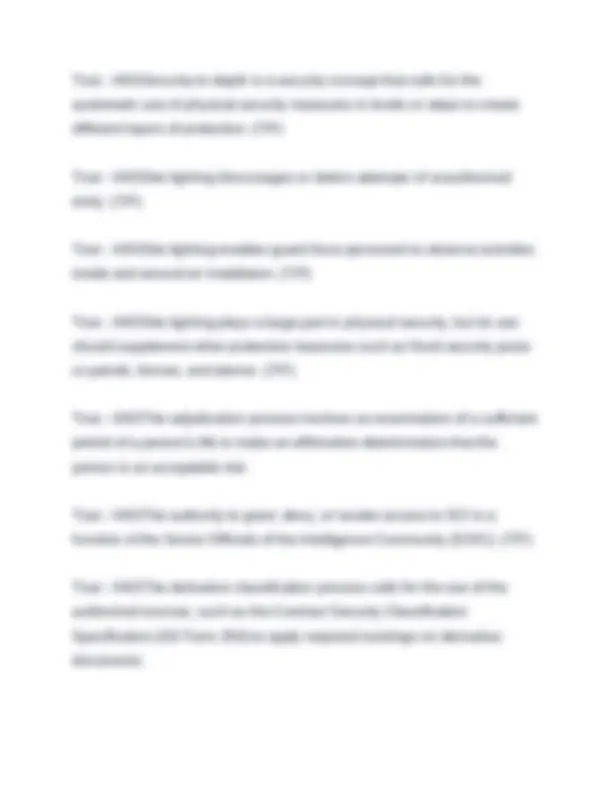
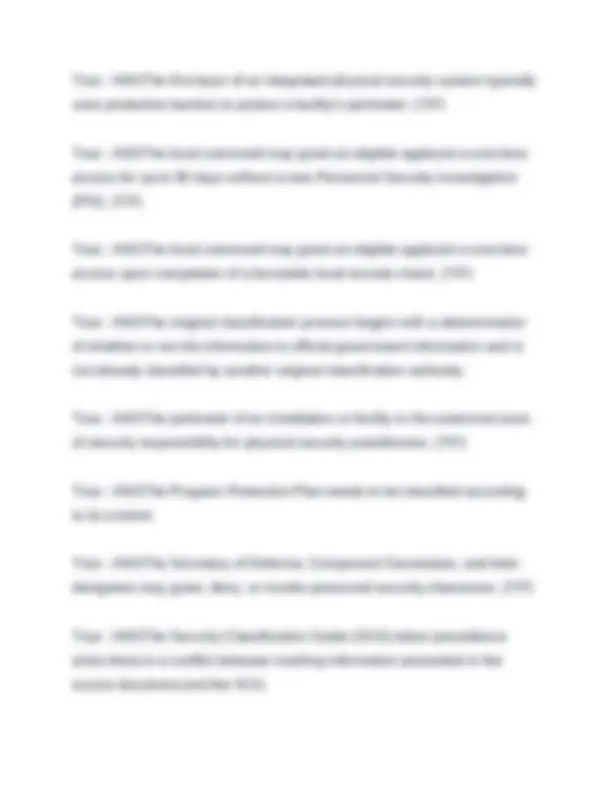
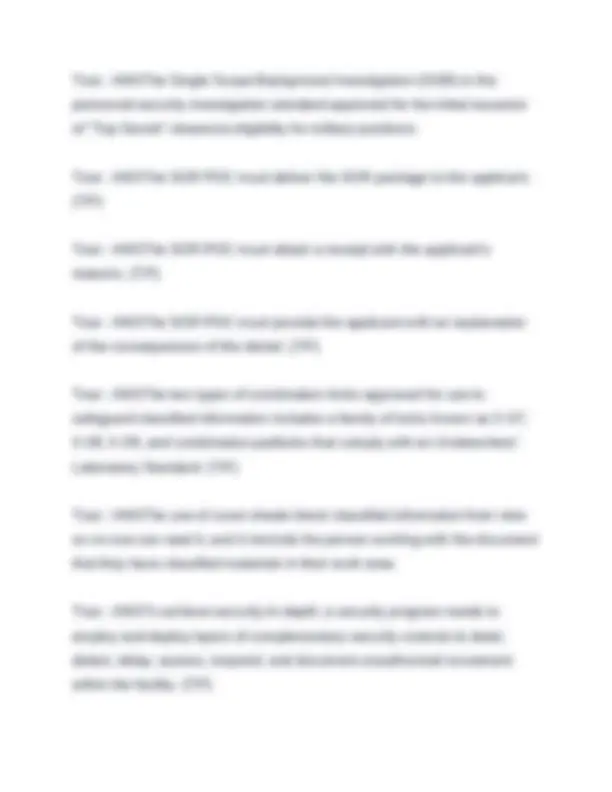
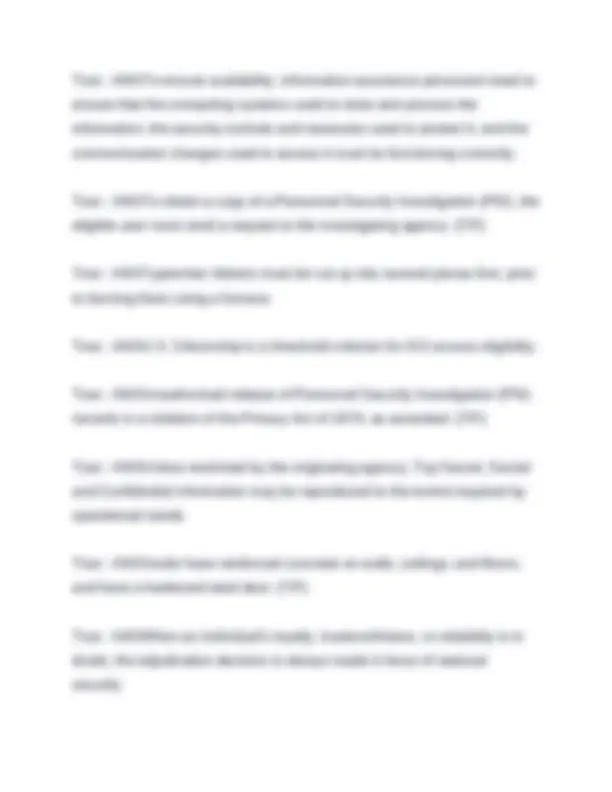



Study with the several resources on Docsity

Earn points by helping other students or get them with a premium plan


Prepare for your exams
Study with the several resources on Docsity

Earn points to download
Earn points by helping other students or get them with a premium plan
Community
Ask the community for help and clear up your study doubts
Discover the best universities in your country according to Docsity users
Free resources
Download our free guides on studying techniques, anxiety management strategies, and thesis advice from Docsity tutors
SPeD - Security Fundamentals Professional Certification (SFPC) Test Bank 2025-2026. Questions & Correct Verified Answers. Graded A
Typology: Exams
1 / 66

This page cannot be seen from the preview
Don't miss anything!



























































Access National Agency Check with Inquiries (ANACI) – ANS Controlled positions that provide support functions to the Nuclear PRP (Personnel Reliability Program) require this Personnel Security Investigation (PSI) type completed within five years prior to assignment to the position. Access National Agency Check with Inquiries (ANACI) - ANSThis Personnel Security Investigation (PSI) combines the NAC with written inquiries to law enforcement agencies, former employers and supervisors, references, schools, and creditors. Adjudication - ANSThis element involves an evaluation of information contained in Personnel Security Investigation (PSI) reports and results in a judgment concerning an individual's security clearance eligibility. Annual Refresher Briefings - ANSThis required briefing aims to: (1) reinforce policies, principles, and procedures covered in previous briefings, (2) remind cleared personnel of their continued security responsibilities, and (3) ensure that they are aware of security threats that they may face.
Anti-Terrorism Officer - ANSThis entity supports the physical security mission by managing the installation's use of defensive measures to reduce the vulnerability of individuals and property from terrorist attacks. Anti-Terrorism Working Group (ATWG) - ANSThis entity is responsible for assessing physical security requirements and for conducting criticality, vulnerability, and risk assessments. Atomic Energy Information (RD/FRD) - ANSOnly the Secretary of the Energy can declassify this type of information. Attestation Briefings - ANSThis briefing requires individuals to orally declare their understanding of their responsibility to protect national security information. Automatic Declassification - ANSBased on Executive Order 13526, this system declassifies all classified records determined to have permanent historical value 25 years from the date of its original classification. This system allows for declassification exemptions for nine categories of information specified in Executive Order 13526, as amended. Chris is correct - ANSTwo security professionals - Chris and Jo - are discussing the destruction of classified documents. •Jo says that the use of the secure volume concept for shredding classified documents refers to the practice of shredding all classified documents that
•Jo says that the steps of personnel security investigations commonly used during an initial inquiry are the: (1) NAC, (2) ENTNAC, (3) ANACI, and (4) SSBI. •Chris says that the type of investigation is based on the sensitivity of the position for which an individual is being considered. •Who is correct? Chris is correct - ANSTwo security professionals - Jo and Chris - are discussing the classification marking process. •Jo says that the first step in marking a document is to identify the overall classification level of the document. •Chris says that the overall classification of a document depends on the highest classification level of information contained in the document. •Who is correct? Chris is correct - ANSTwo security professionals - Jo and Chris - are discussing the position sensitivity designations. •Jo says that sensitivity of the position's most important duty determines its position sensitivity. •Chris says that a position may be designated as critical-sensitive even though the position does not have any requirement for accessing classified information. •Who is correct? Chris is correct - ANSTwo security professionals - Jo and Chris - are discussing the proper marking of a derivatively classified document.
•Jo says that, when a document is derived from multiple sources, the derivative classifier must apply the downgrading instruction that provides the lowest level of classified protection for the shortest period of time. •Chris says that, when a document is derived from multiple sources, the derivative classifier must apply the declassification instruction that provides the highest level of classified protection for the longest period of time. •Who is correct? Chris is correct - ANSTwo security professionals - Jo and Chris - are discussing the topic of derivative classification. •Jo says that derivative classification needs to be reviewed and approved by delegates of the original classification authority. •Chris says that derivative classification refers to an individual's responsibility to properly mark newly developed material consistent with the classification markings specified in authorized sources. •Who is correct? Chris is correct - ANSTwo Security Professionals - Jo and Chris- are discussing physical security threats. •Jo says that natural disasters are considered a physical security threat because they have the potential to damage DoD resources or interrupt activities or operations. •Chris says that, although natural disasters have the potential to damage DoD resources or interrupt activities or operations, they are not considered a physical security threat because they are natural occurring phenomena. •Who is correct?
CI Support Personnel - ANSThis entity supports the physical security mission by providing information on our adversaries' intentions and capabilities. Communications Secretary (COMSEC) - ANSThis type of information includes emission or emanation security material and information. Confidential - ANSThis classification level is the highest level that can be transmitted using the U.S. Postal Service First Class Mail. Continuous Evaluation - ANSThis element involves monitoring employees for new information that could affect their security clearance eligibility status. Courier Briefings - ANSThis briefing informs individuals who will be hand- carrying classified documents of the procedures for handling those documents while in transit. Critical-Sensitive - ANSThis designation is applied to positions that include both critical-sensitive and non-critical sensitive duties. Critical-Sensitive - ANSThis designation is applied to positions that include duties associated with special programs such as Special Access Programs (SAP). Critical-Sensitive - ANSThis designation is typically associated with fiduciary duties requiring the highest degree of public trust.
Criticality - ANSThis concept looks at the importance of a part to the whole. This concept is based on both an asset's importance to national security, and the effect of its partial or complete loss. DD Form 2501- Courier Authorization - ANSThis form authorizes the holder to hand-carry classified information using a transportation mode other than a commercial airline (non-collateral). DD Form 254-DoD Contract Security Classification Specification - ANSThis form provides a contractor specific clearance and access requirements, authorization to generated classified information, and any other special security requirements above and beyond those required by the National Industrial Security Program Operating Manual (NISPOM). DD Form 441-Security Agreement - ANSExecution of this form allows a contractor organization to work on a classified contract and it establishes the government's authority to review the contractor's security program to ensure compliance. DD Form 441-Security Agreement - ANSOnce executed at the time of the facility clearance approval, this form becomes a legally binding document between the contractor and the U.S. Government. Debriefings - ANSThis briefing reminds cleared individuals who no longer need access to classified information of their continued responsibilities to
False - ANSA Department of Defense military member with a National Agency Check adjudicated for suitability is eligible for access to Confidential information. False - ANSA foreign exchange officer assigned to a joint forces command has full access to all classified information provided to the command. False - ANSA local national employed by the Department of Defense in Germany with a ten year-old Single Scope Background Investigation is eligible for access to Secret information. False - ANSA retired Combatant Commander has full access to all levels of classified information she was able to access prior to retirement. False - ANSA security clearance guarantees that any individual will be granted access to classified information. False - ANSA security infraction occurs when any knowing, willful, or negligent action results in the creation of a special access program contrary to the requirements of Executive Order 13526, as amended. False - ANSA security infraction, compared to a security violation, does not place classified information at risk. False - ANSA SF 702 (Security Container Checklist) can be modified to include safety requirements.
False - ANSAdjudication refers to the Department of Defense standard procedure for collecting information about an individual's background, activities, and personal behavior for the purpose of making a personnel security determination. False - ANSAll employees are eligible for an interim security clearance. False - ANSAll individuals with the appropriate personnel clearance level are allowed access to a designated restricted area. (T/F) False - ANSAll security violations involve a compromise of classified information. False - ANSAn information custodian must account for, control, and mark working papers in the same manner required of classified documents. False - ANSAn original classification authority cannot issue a Security Classification Guide until approved by the Information Security Oversight Office (ISOO). False - ANSAny individual with an official need-to-know to conduct assigned duties will be granted a security clearance. False - ANSBecause different assets may require different levels of protection, the security in-depth concept calls for the use of different types of security controls to ensure that each asset has the same level protection. (T/F)
False - ANSFailure to properly downgrade information to a lower classification level is an example of a security infraction. False - ANSIndividuals with dual citizenship are restricted from receiving security clearances. False - ANSMicroforms and microfiche can be shredded using a shredder with the capability to crosscut the material into 1 mm by 5 mm pieces. False - ANSNon-U.S. Citizens are restricted from gaining access to classified information. False - ANSOnly an investigative agency can initiate a Personnel Security Investigation (PSI) request. False - ANSPrior to gaining access to classified information, an individual who wants access to classified information needs to establish that he or she has a need-to-know. False - ANSRequired markings for derivatively classified documents include a concise reason for classification. False - ANSSecure rooms and vaults must be constructed to meet GSA- approved standards. (T/F) False - ANSSecure rooms are usually built to commercial standards and provide a similar level of protection as a vault. (T/F)
False - ANSSF-312 is a contractual agreement between the classified information custodian and the cleared employee stating that the latter agrees never to disclose the classified information to an unauthorized person. False - ANSThe Access National Agency Check with Inquiries (ANACI) is the approved personnel security investigation standard for critical sensitive positions. False - ANSThe Access National Agency Check with Inquiries (ANACI) is the only personnel security investigation standard approved for the initial issuance of clearance eligibility for military positions. False - ANSThe Access National Agency Check with Inquiries (ANACI) is the personnel security investigation standard approved for the initial issuance of "Confidential" clearance eligibility for military positions. False - ANSThe Access National Agency Check with Inquiries (ANACI) is the personnel security investigation standard approved for the initial issuance of clearance eligibility for noncritical-sensitive military positions. False - ANSThe Access National Agency Check with Inquiries (ANACI) is the personnel security investigation standard for noncritical-sensitive positions requiring Top Secret clearance eligibility.
False - ANSThe organizational or command security manager is responsible for developing, approving, and implementing the Program Protection Plan - a single source document that specifies all protection efforts designed to deny unauthorized access to a critical program information. False - ANSThe original classification process only includes the assignment of a classification level to eligible official government information, but not a determination of how long the classification should last. False - ANSThe preparation and implementation of a Program Protection Plan is based on effective application of risk avoidance methodology. False - ANSThe Security Container Sheet (SF 702) is used to record the documents stored in a security container. False - ANSThe security office uses e-QIP to initiate the Personnel Security Investigation (PSI) process. False - ANSThe sender's complete return address needs to be on the inner wrapping, but may not be on the outer wrapping. False - ANSThe SF-703, SF-704, and SF-705 may be used for special or sensitive information other than Top Secret, Secret, and Confidential documents respectively.
False - ANSThe Single Scope Background Investigation (SSBI) and the Access National Agency Check with Inquiries (ANACI) are the only two Personnel Security Investigations approved for the initial issuance of clearance eligibility for all civilian position designations. False - ANSThe Single Scope Background Investigation (SSBI) is the approved personnel security investigation standard for non-critical sensitive civilian positions. False - ANSThe Single Scope Background Investigation (SSBI) is the personnel security investigation standard for non-sensitive positions requiring Top Secret clearance eligibility. False - ANSThe Single Scope Background Investigations (SSBI) is the personnel security investigation standard approved for the initial issuance of "Secret" clearance eligibility for military positions. False - ANSThe SOR POC must assist the applicant to develop a SOR reply. (T/F) False - ANSU.S. relief agency liaison officers have access to raw intelligence images and data related to humanitarian efforts. False - ANSUse of emergency lighting is reserved for situations when additional lighting is necessary. (T/F)
FPCON CHARLIE - ANSWhich of the following FPCON levels indicates the existence of an increased threat of terrorist activity? Identification Systems and Methods - ANSThe facility access control procedure employs various types of entry control devices including the use of the Common Access Card Identification Systems and Methods - ANSThe Homeland Security Presidential Directive 12 (HSPD 12) aims to reduce the number of systems used in this facility access control procedures by mandating common system criteria. Identification Systems and Methods - ANSThis facility access control procedure employs the use of physical security countermeasures including automated entry control systems, exchange badge systems, and security personnel conducting physical inspection of your credentials. IMCON - ANSThis control marking is used on imagery representations and reporting that identify sensitive analytical methods or intelligence sources. Indoctrination Briefings - ANSThis briefing provides appropriately cleared personnel with information on how to protect special types of classified information (e.g., SCI or SAP) prior to gaining access to the information.
Information System Security Managers (ISSM) - ANSThis entity is responsible for coordinating physical security measures to protect information systems. Initial Orientation Briefings - ANSThis required briefing informs newly cleared personnel of their responsibilities as a member of the cleared community. Installation Commander/Facility Director - ANSThis entity has overall responsibility for the safety and protection of the people and property in an installation or a facility. Investigation - ANSThis element results in a report that contains background information about the person selected for a sensitive duty. Jo and Chris are both correct - ANS•Two security professionals - Jo and Chris - are discussing compilation. •Jo says that classification by compilation includes situations when two or more pieces of unclassified information, when combined or associated, warrant protection as classified information. •Chris says that the classification by compilation applies when pieces of information classified at a lower level, by virtue of being combined or associated, warrant a higher classification level. •Who is correct? Jo and Chris are both correct - ANS•Two security professionals- Jo and Chris- are discussing procedures for safeguarding classified information.